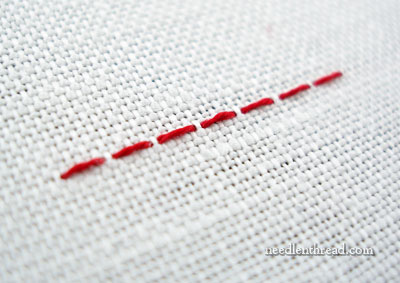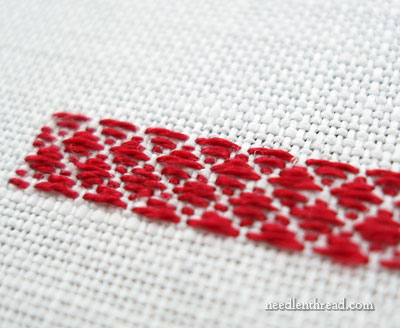Never underestimate simple stitches.
Take, for example, the running stitch. It is the simplest of embroidery stitches. But you can do a lot with it! The running stitch can be used as a filling, it can be used to form the foundation of compound stitches, it can be “dressed up” by being laced or whipped with another color of thread. Simple – yes. But versatile, too!
Here, I’m working with the wrong thread, the wrong fabric, and the wrong needle. I was demonstrating pattern darning to a student, explaining that running stitch should not be poo-pooed just because it’s such a simple stitch.

Here’s a basic running stitch, worked in one strand of floss. Notice the regularity of the size of the stitch and the regularity of the spacing. Working on linen, whether it’s even-weave linen or not, it’s pretty easy to work regular running stitches and to space them regularly, too. By counting the linen threads over which each stitch is taken, uniformity is easy to achieve.

Of course, this uniformity would be even more uniform on an even-weave fabric, but for pattern darning (which is what this technique is called), I prefer plain-weave linen. It has more character. (Yes, this is one of those moments when irregularity and a bit of wonkiness is referred to as “character.” It’s kind of like my old, crooked house. We don’t say it’s crooked. We say it “has character.”)

Pattern darning (using running stitch – or “darning stitch” – to create fill patterns) is not necessarily a counted technique. It can be done, believe it or not, on plain-weave, high thread count fabrics like muslin or silk. But it’s a lot easier on a linen, where you can see the individual threads in the fabric and use them as a guide.

Notice that I’m just working running stitch in rows, back and forth, and changing the size of the stitches to create a pattern. Nothing complicated here!

The more rows you make, the more the pattern emerges. This is a simple diamond pattern.

This little bit is worked on a pretty high count linen (about 50 threads / inch). The scissors are my 3.5″ embroidery scissors, just to give a sense of scale.
To work out interesting darning patterns that can be used on linen so that the threads of the fabric can act as a guide, play around on graph paper. It’s a fun way to develop neat patterns. Just remember that your pattern has to develop in lines that are worked either horizontally or vertically, so that they can be worked out on the fabric in lines of running stitch. There are all types of ways you can use running stitch to create interesting pattern darning designs.
Grace Christie’s book, Samplers & Stitches, has a nice section on pattern darning, beginning around page 108 of the text. You can find the book online and download it for free. I’ve linked to it in this article that reviews Samplers & Stitches by Grace Christie. It’s a wonderful book!
So, the next time you’re thinking that running stitch is just a ho-hum stitch, try some pattern darning! It’s fun, it’s beautiful, and it’s a great way to add a patterned fill to your embroidery projects.







It was neat to watch the pattern emerge.
Mary,
Thank you sew much for your blog. You consistantly teach and enourage others in the art of GORGEOUS and fine needlework. Your love the art is felt in every post.
Taking the simple you turn it into the sublime and give the tedious a reson to be enjoyed rather than merely conquered.
Just wanted to let you know I appreciate your hard work in producing such an amazing “center” of learning, and fun! I don’t comment often, but I read and learn, and drool always! lol
Have a blessed Christmas!!!
Thank you!
Thanks for the reminder that not all embroidery has to be a major production with fancy stitches and materials. Sometimes a project that you can develope a *somewhat* mindless rhythm is just what’s needed.
There is an Indian embroidery technique called ‘Kantha’ which is done entirely with running stitches.
http://en.wikipedia.org/wiki/Kantha
wow, I have a need of this stitch! thanks. I’m not good at making them very even, is there any tricks to it or just practice?
OH, and if you click on my website y
This is a beautiful post. Thank you for for the beautiful demonstration.
Wow. Never thought that simple stitches can turn into interesting pattern. Thanks for sharing.
I agree with you about linen, and the “wonkiness.”
I don’t like to stitch on evenweave, because I get bored, it is too even.
Jane
very interesting. Thanks Mary
I like the simple stitches just for the reasons you mentioned (whipping, pattern darning). Easy, fast — but also very decorative when used “right” and creatively.
It’s so neat seeing the pattern slowly emerge when doing pattern darning. With just a few simple variations of the length of the individual stitches, you can get fab patterns. Be it one row wide or several. With counted threads, it’s so easy and rewarding for complete newbies too.
In my bookshelf, there’s a book by Jane Davis where she shows how to make beaded running stitches (and pattern darning). That’s another way to make this simple stitch decorative.
Last time I did any darning myself it was using a textured viscose bouclé yarn that was so pretty in itself that no special stitches were needed, really. Ok, that was on somewhat wide-meshed tulle so it looked a bit different from running stitches on other fabrics.
Beautiful post, sometimes an easy stitch is as wonderful as sophisticated long and short stitches.
You’ve made a pretty pattern! I know it’s another stitch, but it’s looks a little bit like traditional Slavic embroidery, for example Ukrainian cross stitch
The link above is full of free patterns in English.
What a great post! I have learned so much through your blog, thank you very very much!
I’ve never seen this done before. It reminds me of the days when I worked with huck toweling, just simple running stitches going this way and that to create a wonderful pattern. But huck toweling is hard to find. Now I know I can do the same thing on evenweave. Clever and nice to know.
I was hoping you had a chart showing all the stitches in photos that I can print out and keep with me when I embroider.
Thanks
Hi, Mary
I wonder if you have ever worked with quality colored huck fabric. If so, where did you get it? I have searched everywhere but Heaven and have had no luck. Any suggestions? Maybe some of your fans have any.
Thanks,
Adele